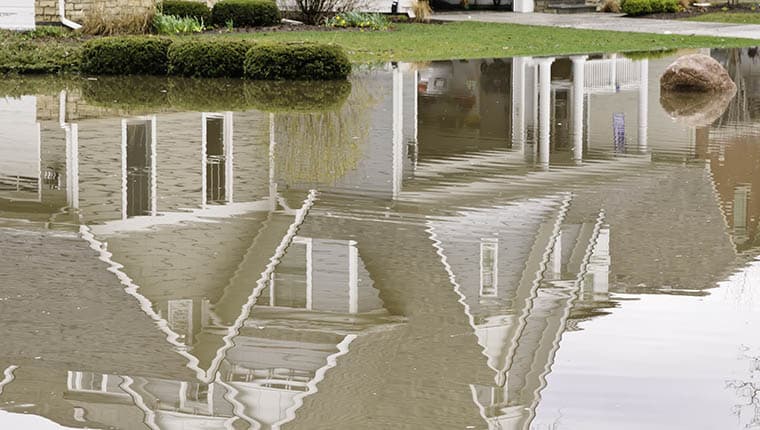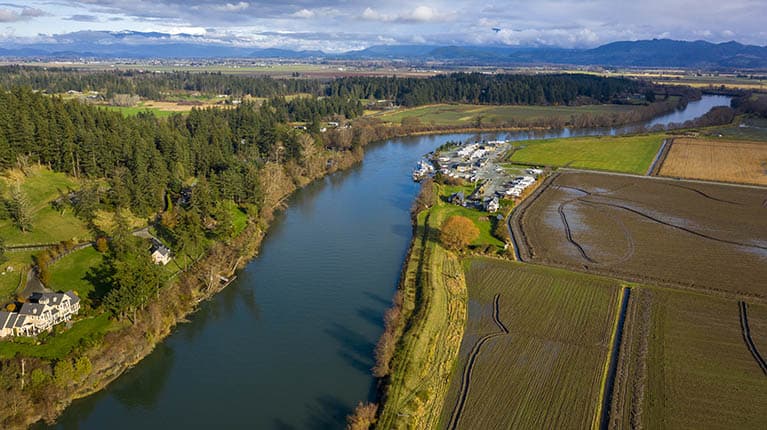Flood risk is a serious concern. Flood insurance can be a critical tool to help protect your home or business. Learn how flood insurance works in this article.
Floods are among the most common and costly natural disasters in the United States, and the risk of flooding is only expected to grow. Whether you're a homeowner or a business owner, understanding flood insurance is important in helping to protect your property and financial stability. This article delves into the details of flood insurance, explaining how it works, what it typically covers, and how to navigate the options available through both the National Flood Insurance Program (NFIP) and private flood insurers.
Navigating the Waters: Understanding How Flood Insurance Works
Flood Insurance Basics
Flood insurance is a specific type of property-related insurance that covers physical damage to your property caused by flooding. While homeowners insurance typically includes coverage for sudden and accidental water damage from internal sources, such as a burst pipe or a faulty appliance, standard homeowners insurance policies generally do not cover flood damage caused by natural disasters, like heavy rain or hurricanes. Similarly, standard business insurance policies generally do not cover flood damage caused by natural disasters. Flood insurance is designed to fill this gap, helping to provide financial protection against the potentially devastating effects of floods.
What Is Considered a Flood?
The NFIP defines flooding as “a general and temporary condition where two or more properties or two or more contiguous acres of normally dry land are inundated by water or mudflow.” Generally, this includes:
- Overflow of inland or tidal waters
- Unusual and rapid accumulation or runoff of surface waters from any source
- Mudflows, if the primary cause is an accumulation of water on the surface or runoff
What Is Not Considered a Flood?
For flood insurance coverage purposes, water damage which is typically not considered “flood” damage, generally includes the types of water intrusion that can occur from sources other than rising water or overflow of natural bodies of water. Claims arising from these types of water damage are typically not covered under flood insurance policies and can include, for example:
- Plumbing Failures: Issues like burst pipes, leaking faucets, or faulty water heaters that cause water damage inside your home.
- Appliance Leaks: Water damage from appliances such as washing machines, dishwashers, or refrigerators.
- Roof Leaks: Water damage that results from a leaking roof due to a storm or wear and tear may be covered under a homeowner's insurance policy rather than flood insurance.
- Rainwater: Water entering your home due to heavy rain seeping through cracks, doors, or windows, as long as it is not due to flooding.
- Sewer Backups: Often classified differently, sewer backups may require specific insurance endorsements or policies aside from flood insurance.
Who Should Consider Flood Insurance?
While flood insurance is required for properties in high-risk flood zones with a federally-backed mortgage, anyone can purchase flood insurance, and it's often recommended even in low-risk areas. According to FEMA, over 20% of NFIP flood claims come from outside high-risk zones.
What Is the National Flood Insurance Program (NFIP)?
The NFIP is a federal program administered by the Federal Emergency Management Agency (FEMA). It was created in 1968 to help provide affordable flood insurance to property owners and to encourage communities to adopt and enforce floodplain management regulations.
How Does the NFIP Work?
The NFIP operates through a network of private insurance companies that sell and service flood insurance policies. FEMA sets the rates and coverage rules, and the insurers partnering with the NFIP underwrite the policies.
Eligibility for an NFIP policy includes the following five factors:
- Community Participation: The property must be located within a community that participates in the NFIP.
- Property Type: Almost any residential, commercial, or rental property, including single-family homes, multi-family buildings, and certain mobile homes in participating communities, can be covered under the NFIP.
- Building Compliance: The building must adhere to specific NFIP criteria, such as elevation and construction standards, especially if it is in a Special Flood Hazard Area (SFHA). Newly constructed buildings or substantially improved properties are subject to stricter regulations.
- Past Flood Insurance: Eligibility may also consider the property's claims history. Repeatedly flooded and rebuilt properties might encounter different considerations for coverage.
- Purchase Requirement: Although there isn't an income or prior insurance condition for NFIP policies, properties with federally backed mortgages in high-risk flood zones (SFHAs) are often required to carry flood insurance.
NFIP Policies Coverage Limits
NFIP policies with coverage for both building and personal property have the following current maximum coverage limits as of April 2025:
Building Coverage: $250,000 for residential buildings, and $500,000 for commercial buildings and residential structures of five or more units.
Personal Property Coverage: $100,000 for residential contents coverage including residential structures of five or more units, and $500,000 for contents of commercial buildings.
NFIP policyholders can choose their amount of coverage, up to the maximums.
What NFIP Policies Typically Cover
Building Coverage: NFIP policies typically cover direct physical damage to the insured building, including:
- Structural elements (walls, floors, foundation)
- Electrical and plumbing systems
- Furnaces, central air conditioners, and water heaters
- Detached garages (up to 10% of the building coverage)
Personal Property Coverage: NFIP policies typically cover direct physical damage to personal belongings, including clothing, furniture, and electronics, appliances, and curtains.
What NFIP Policies Typically Don't Cover
NFIP policies typically cover flood damages directly resulting from water events like storm surges, hurricanes, or excessive rain leading to overland water movement—strictly separated from any earth-moving events that could compromise the ground's stability independently of the water conditions. For example, NFIP polices do not cover landslide damage, mudslides and mudflows caused by earth movement, sinkholes, and earthquakes.
In addition, NFIP policies typically do not cover:
- Additional Living Expenses (ALE) or loss of use
- Financial losses caused by business interruption
- Currency, precious metals, and valuable papers
- Vehicles
- Property and belongings outside of an insured building, such as landscaping, wells, septic systems, decks, and patios
The NFIP Waiting Period
There is typically a 30-day waiting period between the date of purchase and the effective date of an NFIP flood insurance policy. There are a few exceptions to this rule, such as when flood insurance is required as a condition of a loan or when coverage is purchased in connection with a map revision.
What Is Private Flood Insurance?
Private flood insurance companies offer policies that are not part of the NFIP and have the flexibility to provide different coverage amount options, terms, and pricing. In recent years, the private flood insurance market has grown, offering homeowners and business owners more options for flood protection.
How Does Private Flood Insurance Work?
Private flood insurance functions similarly to the policies offered by the NFIP, but it is provided by private insurance companies rather than the government. Private flood insurance companies operate independently of the NFIP. They assess risk and set premiums based on their own underwriting models.
Private Flood Insurance Coverage Limits
Private flood insurance policies often offer higher coverage limits than the NFIP, which can benefit owners of high-value properties. Available coverage limits can vary widely depending on insurer.
What Private Flood Insurance Typically Covers
While the terms and conditions of each policy may vary, private flood insurance policies typically offer coverage similar to the NFIP, but with greater flexibility and customization.
Building Coverage: Covers damage to the structure of your home, including the foundation, walls, and roof.
Personal Property Coverage: Covers damage to your personal property, such as furniture, clothing, and electronics.
What Private Flood Insurance Typically Doesn't Cover
Like NFIP policies, private flood insurance policies typically do not include coverage for:
- Damage caused by earth movement: Earth movement such as landslides, mudflows, or erosion, even if caused by flooding, are typically excluded.
- Additional living expenses or loss of use: Costs associated with temporary housing or additional living expenses while repairs are being made to the flooded property are typically not covered.
- Financial losses caused by business interruption: Loss of income or additional expenses arising from the interruption of business activities due to flood conditions are generally not covered.
- Damage or loss of currency, precious metals, and valuable papers: Loss or damage to cash, currency, valuable papers, gold, and securities, for example, is typically excluded from coverage.
- Damage to vehicles: Certain personal property, such as automobiles and recreational vehicles, are usually not covered under flood insurance polices and may require separate insurance policies.
Private Flood Insurance Waiting Period
Some private flood insurance policies may have a shorter waiting period than the NFIP's 30 days. For private flood insurance, the waiting period is often around 10-14 days. However, this can depend on the insurer and the specific terms of the policy. It is crucial to check with your private flood insurance provider for the exact waiting period, as it may vary based on their policies and any potential regulation changes.
Flood insurance is a critical tool for helping to protect your property and financial well-being in the face of flood risk.
NFIP vs. Private Flood Insurance: Key Differences
There are some key differences between NFIP and private flood insurance. Private flood insurance commonly offers higher coverage limits than the NFIP, providing more extensive financial protection. Pricing can also differ significantly; while private flood insurance may present more competitive rates for lower-risk properties, rates could be higher for properties deemed high-risk. Another advantage of private flood insurance can be a shorter waiting period for policy effectiveness compared to the standard 30-day waiting period with NFIP. The NFIP also has clear eligibility criteria (as set forth above).
How to Purchase Flood Insurance
NFIP: You can purchase NFIP flood insurance through a licensed insurance agent who participates in the NFIP.
Private Flood Insurance: You can purchase private flood insurance through a licensed insurance agent or directly from a private insurance company.
Factors Affecting Flood Insurance Costs
Several factors can influence the cost of flood insurance, including, but not limited to:
- Flood Zone: Properties in high-risk flood zones typically have higher insurance rates.
- Elevation: The elevation of your property relative to the base flood elevation (BFE) can affect your rates.
- Building Characteristics: The type of construction, age, and occupancy of your building can impact your rates.
- Coverage Limits: Higher coverage limits typically result in higher premiums.
- Deductible: Choosing a higher deductible can lower your premium but may also increase your out-of-pocket costs in the event of a flood.
- Community Rating System (CRS): If your community participates in the CRS, you may be eligible for a discount on your flood insurance rates.
FEMA Flood Maps and Risk Zones
Flood maps, also known as Flood Insurance Rate Maps (FIRMs), are used to delineate flood risk zones. These maps are created by FEMA and are used by the NFIP and also generally by private insurers to help determine flood insurance rates. Understanding your property's flood zone is essential for assessing your flood risk and determining your insurance needs. You can find your property's flood zone by visiting FEMA's Flood Map Service Center or by contacting your local floodplain administrator.
Filing a Flood Insurance Claim
If your property sustains flood damage, it's important to file a claim with your insurance company as soon as possible. Here are some helpful steps involved in filing a flood insurance claim:
- Notify Your Insurer: Contact your insurance agent or company to report the damage and begin the claims process.
- Document the Damage: Take photos and videos of the flood damage, if safe to do so.
- Prevent Further Damage: Take steps to prevent further damage to your property, such as covering damaged areas with tarps, if safe to do so.
- Complete a Proof of Loss: Your insurer should provide you with a Proof of Loss form, which you must complete and submit within a specified timeframe (usually 60 days).
- Meet with a Claims Adjuster: An insurance adjuster will be assigned to inspect the damage and prepare an estimate of the cost of repairs.
- Review and Approve the Estimate: Review the adjuster's estimate and discuss any discrepancies with your insurer.
- Receive Payment: Once you approve the estimate, your insurer should issue payment for any covered damages. Depending on the terms and conditions of the policy involved, insurers will typically either pay the policyholder directly or pay the contractor doing any restoration/repair work directly. The specific payment method may depend on various factors, including the nature of the claim, the insurance policy's terms and conditions, and any arrangements made between the insurance company, the policyholder, and the contractors.
In Conclusion
Flood insurance is a critical tool for helping to protect your property and financial well-being in the face of flood risk. Whether you choose to purchase flood insurance through the NFIP or a private insurer, understanding the basics of flood insurance, your flood insurance coverage options, and the claims process is essential for navigating the waters of flood protection. Staying informed and proactive about flood insurance will help you safeguard your assets as flood risks evolve.
Acrisure can help you find the right flood insurance solution for your home or business. Contact us today to discuss your options or get started and request a flood insurance quote online now.







